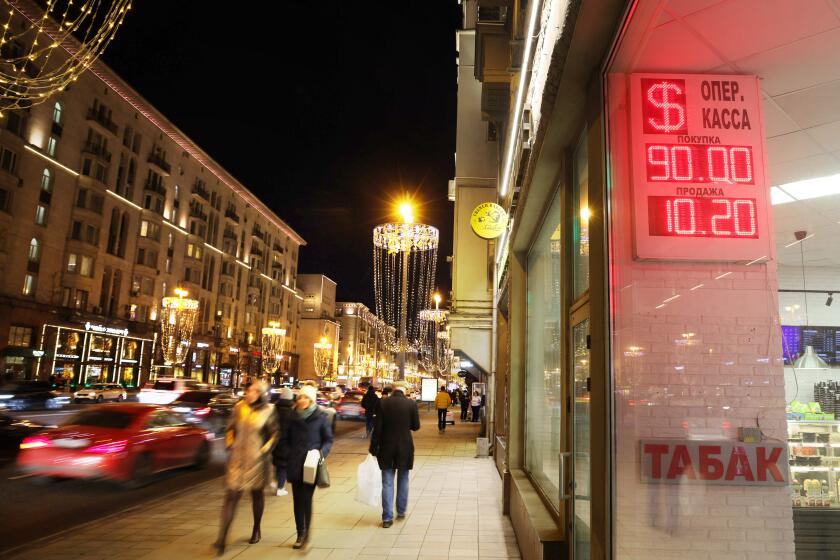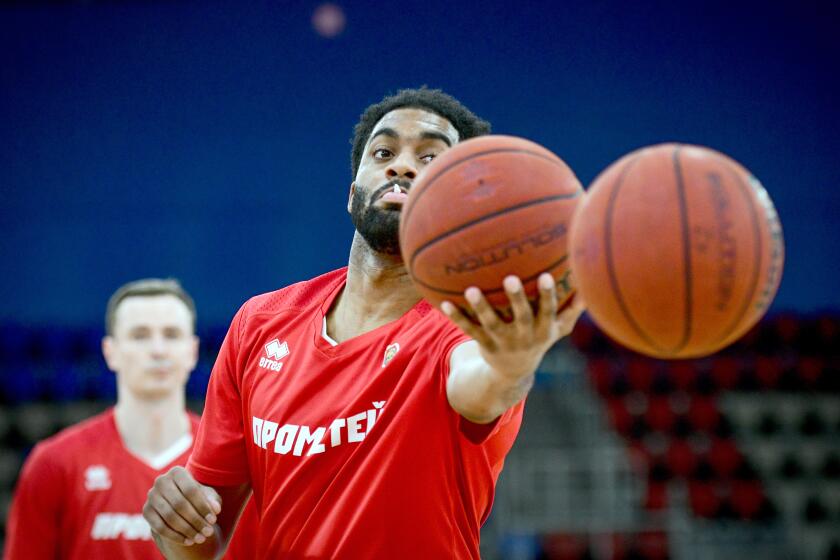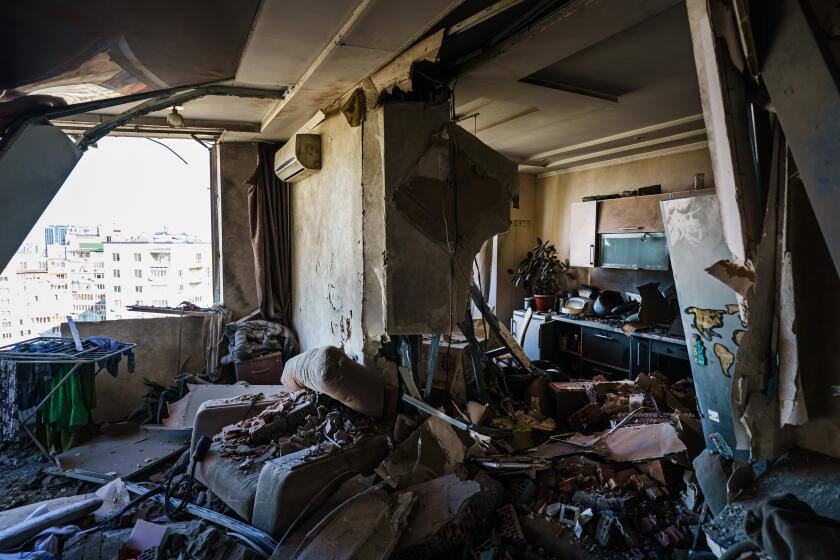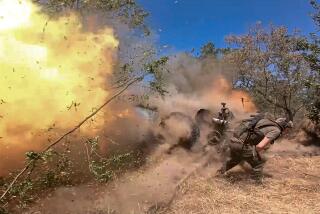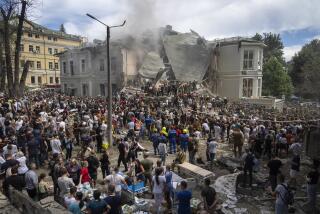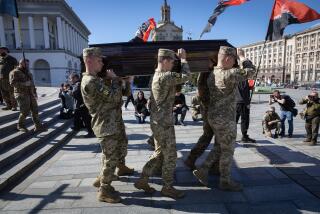Russia captures Ukrainian port city, faces world censure as attacks intensify

KYIV, Ukraine — Russian forces Wednesday intensified a wide-ranging offensive targeting key Ukrainian cities, menacing the capital, Kyiv, with a miles-long military convoy, launching deadly strikes on the second-largest city, Kharkiv, and seizing a strategic Black Sea port city with tanks and troops.
On the seventh day of a war marked by fierce Ukrainian resistance against advancing Russian firepower, Moscow faced growing international denunciations. The United Nations General Assembly overwhelmingly approved a resolution condemning the invasion, and President Biden said it was “clear” that Russia was deliberately targeting civilians.
The capture of the port of Kherson, a city of some 300,000 people, marked the expanding reach of Russian forces across the south.
Residents posted videos showing Russian soldiers and tanks entering the city. Drone footage taken over a bridge near Kherson appeared to depict a battle between Ukrainian soldiers and Russian troops backed by artillery.
The mayor, Igor Kolykhayev, posted a message on Facebook saying that Russian troops had entered the city council building.
In an unusual revelation, Russia — traditionally secretive about combat casualties — for the first time provided an accounting of its battlefield deaths, with the Ministry of Defense acknowledging that 498 soldiers had been killed and 1,597 wounded since the start of its assault. Ukraine has claimed that more than 10 times as many Russian soldiers have died.
Meanwhile, the Kremlin said a delegation was ready to hold talks with Ukrainian representatives in neighboring Belarus. Ukrainian officials also confirmed their readiness to hold discussions, which would be the second such session since the conflict erupted.
In Kyiv, a city of nearly 3 million people, sirens wailed repeatedly after dark and at least one heavy explosion shook buildings. Defenders — a motley mix of regular army troops and ad hoc civilian militias — braced for an expected full-scale attack, erecting makeshift barricades from branches, cinderblocks and vehicles, stockpiling ammunition and establishing lookouts.
Daylight on Wednesday in the snow-blanketed capital revealed the destructive power of a Russian missile strike the previous evening that killed five people, wounded five others and damaged a building on the grounds of the country’s main Holocaust memorial, Babyn Yar.
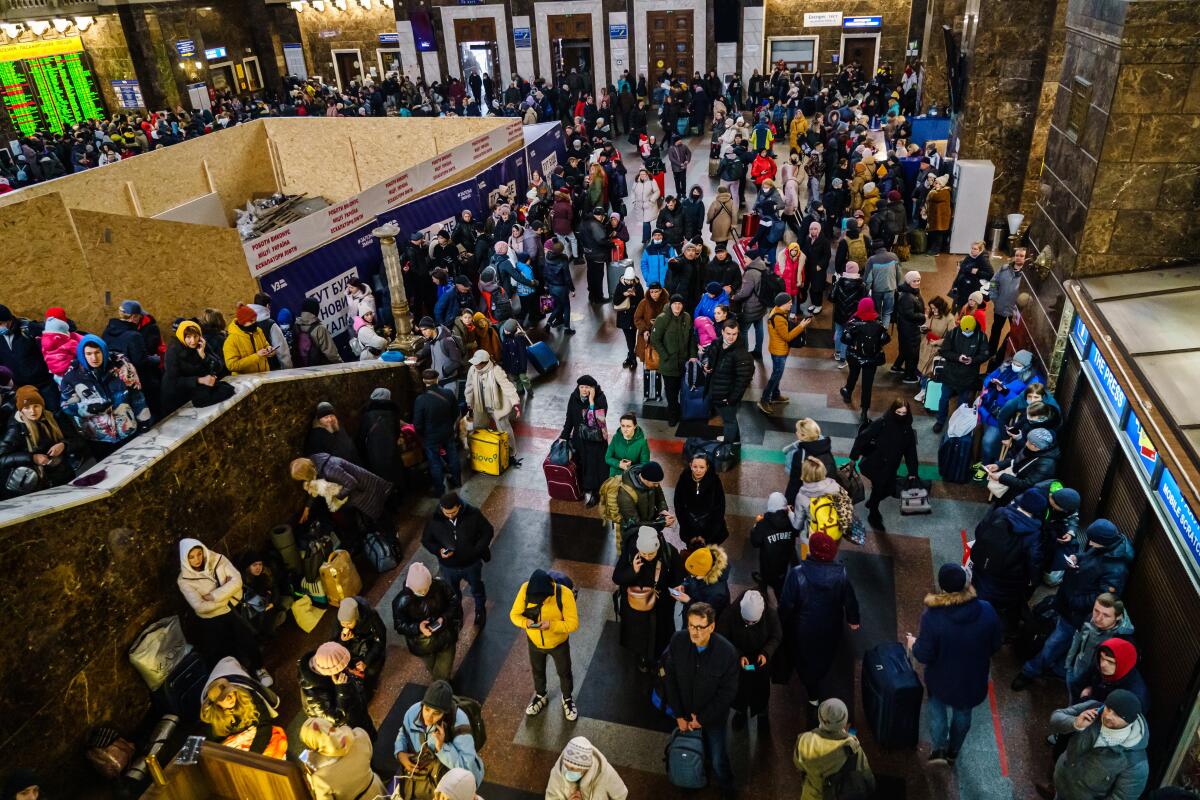
In the aftermath, the city’s landmark television tower, erected in 1973, remained standing, but the blast disemboweled a nearby commercial building, blowing out the windows of a gym and roasting treadmills arrayed in a line. An automotive-supply store nearby was a chaotic maw of glass shards and car parts. The shock wave burst open a billboard and left power lines dangling onto the street.
Even with the cratering ruble, Hollywood movies on hold and snarled metro payments, Putin still holds sway among many Russians despite sanctions.
Some of the most harrowing scenes of the invasion have emerged in Kharkiv, where blasts in recent days have devastated the city’s central square and other populated areas. More deadly strikes occurred Wednesday, Ukrainian officials said, with witnesses reporting explosions that shattered building facades and lighted up the cityscape with fireballs.
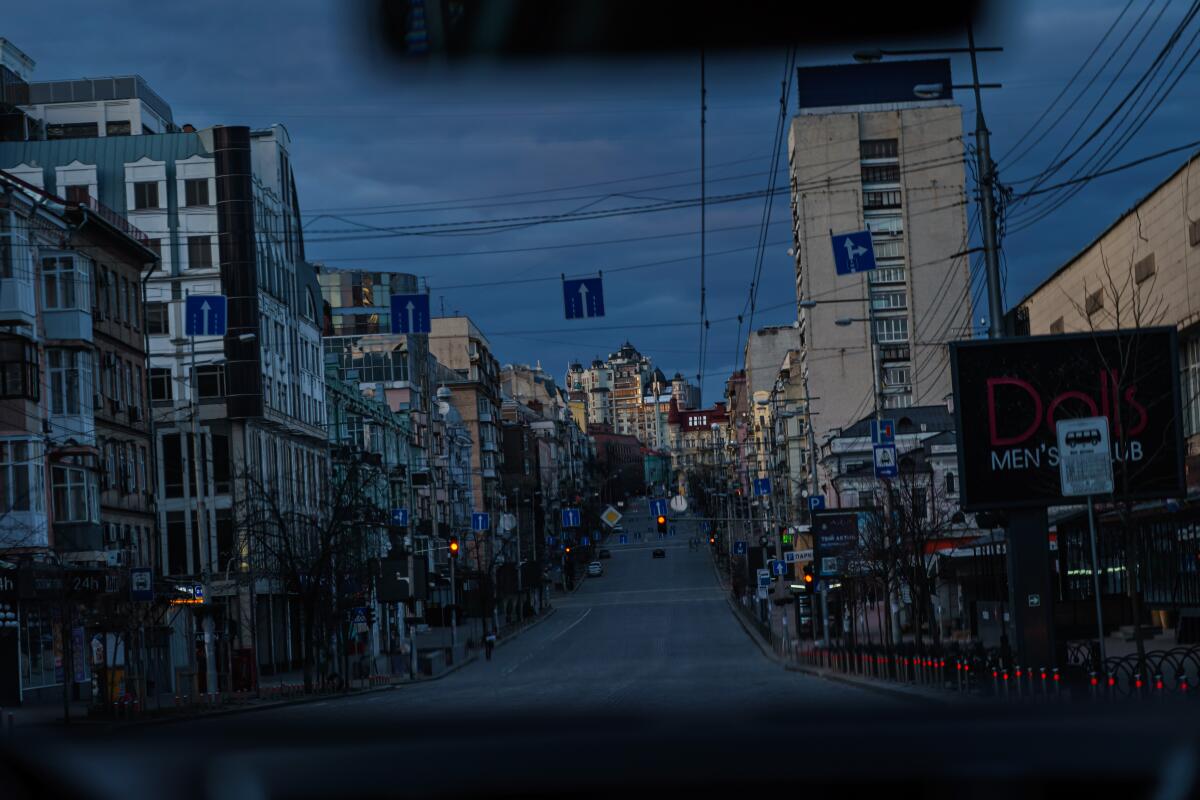
Kharkiv lies only a few dozen miles from the border with Russia, and its largely Russian-speaking population has sometimes been considered to have closer ties to Moscow than Kyiv. But the city’s mayor, Igor Terekhov, said in a video uploaded Wednesday that attitudes toward Russia had changed completely after “unforgivable” attacks.
Ukarine has been a popular haven for U.S. basketball players; two shared their eyewitness accounts of a Russian invasion they say revealed horror and humanity.
“All over the city of Kharkiv, there’s intense fighting from all sides, and obviously this situation is very dangerous,” the mayor told the BBC, adding defiantly: “We are not frightened. You cannot frighten the city of Kharkiv.”
Repercussions continued to widen Wednesday from the Ukraine conflict, Europe’s largest land war in decades.
The U.N. reported that the invasion has sent more than a million people fleeing Ukraine — more than 2% of the country’s population — in the fastest exodus anywhere this century.
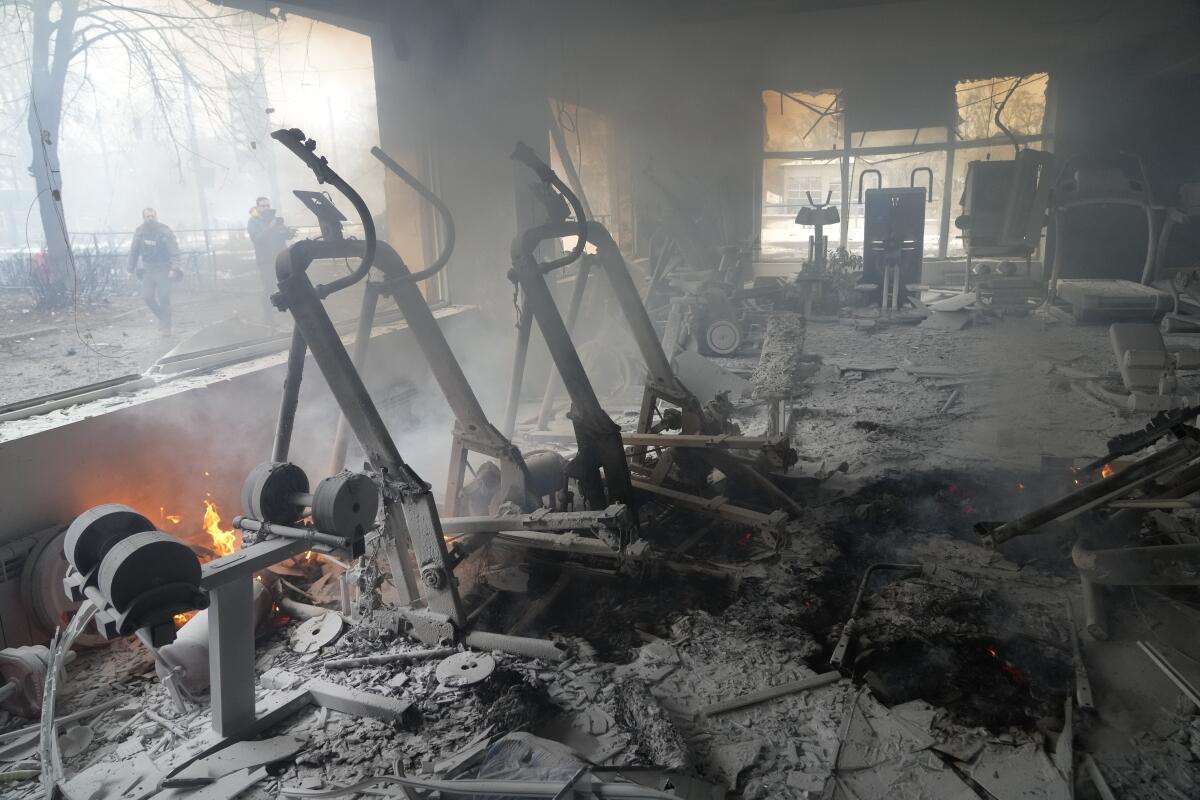
Sanctions from a reinvigorated Western alliance have begun to pummel the Russian economy, sending the ruble plunging and crippling parts of the financial sector.
Moscow has denounced the punitive steps as illegitimate.
Undeterred, the Biden administration on Wednesday announced new measures punishing Russia’s defense industry and applying many of the restrictions to Russia’s neighbor and ally Belarus.
A total of 22 entities that form part of Russia’s “war machine” including companies that produce combat aircraft, infantry fighting vehicles and military electronic systems will be denied access to any trade or dealings with U.S. money or firms, U.S. officials said.
In recent days, Russian officials from President Vladimir Putin on down have employed heightened, heated rhetoric of a type not heard since the Cold War. On Wednesday, Russian Foreign Minister Sergei Lavrov was quoted by the RIA news agency as saying that if a third world war were to erupt, it would involve nuclear weapons.
The U.S. was scheduled to conduct a routine test of intercontinental ballistic missiles this week, but the Pentagon announced Wednesday that it was postponing that exercise.
“We have no intention in engaging in any actions that can be misunderstood, or misconstrued,” spokesman John Kirby told reporters.
“We recognize at this moment of tension, how critical it is that both the United States and Russia bear in mind the risk of miscalculation and take steps to reduce those risks,” he said.
Russia’s diplomatic isolation was growing. The U.N. General Assembly resolution demanding that Moscow immediately stop using force against Ukraine and withdraw its military from the country was approved by a vote of 141 to 5, with 35 abstentions.
“If the U.N. has any purpose, it is to prevent war, to condemn war, to end war,” the U.S. permanent representative, Linda Thomas-Greenfield, told the assembly.
While there were no overt signs that Putin’s iron grip on power in Russia was loosening, jailed opposition figure Alexei Navalny urged compatriots to rise up in protest against Putin and the war. In a Twitter statement posted by a spokeswoman, Navalny called Putin an “insane czar.”
In Ukraine’s southern coastal regions, Russian forces can use their takeover of Kherson as a Black Sea outpost and a springboard for an attack on Odessa, the crown jewel of Ukraine’s port cities.
After Russian soldiers entered the city, the mayor urged the occupiers not to shoot anyone, writing on Facebook: “We don’t have Ukrainian Armed Forces in the city, only civilians and people who want to LIVE here!”
Russian bombardment also rained down on Mariupol, a strategic city on the Sea of Azov, where the mayor was quoted by the Interfax news agency as saying shelling had been so relentless that “we cannot even take the wounded from the streets.”
U.S. and its allies have held off on taking the toughest sanction against Russia over Ukraine, worried about risks of political and economic blowback.
For Kyiv’s hunkered-down residents, Tuesday night’s missile strike near the TV tower provided the most potent demonstration of the military threat facing the capital. But on Wednesday, people were out on the streets in greater numbers than in past days, with cars navigating newly erected checkpoints and pedestrians out replenishing water and food supplies.
The massive Russian convoy, which stretches for 40 miles but remains stalled about 16 miles north of the city, has become emblematic of logistical stumbles by the invading force, including what Western officials say are supply shortages that have bogged down some troop movements.
A senior U.S. Defense official, speaking on condition of anonymity, told reporters the armored column had been at a near-standstill for days, with Ukrainian forces taking advantage of its relative immobility to mount sporadic attacks.
But Western military analysts and officials believe that Putin and his generals, if frustrated by the initial sluggishness of the advance, might resort to overwhelming force directed at civilian areas, a hallmark of past Russian offensives elsewhere.
An all-out assault on Kyiv would probably result in a staggering degree of carnage, either in the form of blanket bombardment to pave the way for advancing Russian troops, or in bloody urban warfare as the invaders confront home-turf defenders determined to fight for every street corner.
British Defense Secretary Ben Wallace predicted growing “brutality” on Putin’s part in coming days.
“He surrounds cities, he ruthlessly bombards them at night,” Wallace said in a radio interview. “And he will then eventually try and break them.”
U.S. Secretary of State Antony J. Blinken said that “hundreds if not thousands” of Ukrainian civilians are believed to have been killed.
Kyiv Mayor Vitali Klitschko said that though Russian forces were moving closer to the capital, the city was prepared and that critical infrastructure, including public transportation, was still functioning.
“Do not believe misinformation intended to break Ukrainians. Kyiv stands and will stand. We will fight,” he said in a video message Wednesday.
Russia now appears to be targeting government buildings and residential apartments, killing civilians and stirring chaos.
Despite the looming threat, even those sheltering in the depths of a metro station near the scene of Tuesday night’s missile strike said they had become accustomed to a new rhythm of life in the capital.
“We felt scared in the beginning, yes, but now, after a week?” said Julia Andreyivna, 25, a manager at a magazine publisher who sat on an inflatable mattress, cradling her cat, Mark. “We feel OK. It’s become routine.”
She had no intention of leaving the capital.
“We’re staying,” she said. “This is our Kyiv.”
Bulos reported from Kyiv and King from Washington. Times staff writers Erin B. Logan, Tracy Wilkinson and Eli Stokols in Washington and Henry Chu in London contributed to this report.
More to Read
Sign up for Essential California
The most important California stories and recommendations in your inbox every morning.
You may occasionally receive promotional content from the Los Angeles Times.
